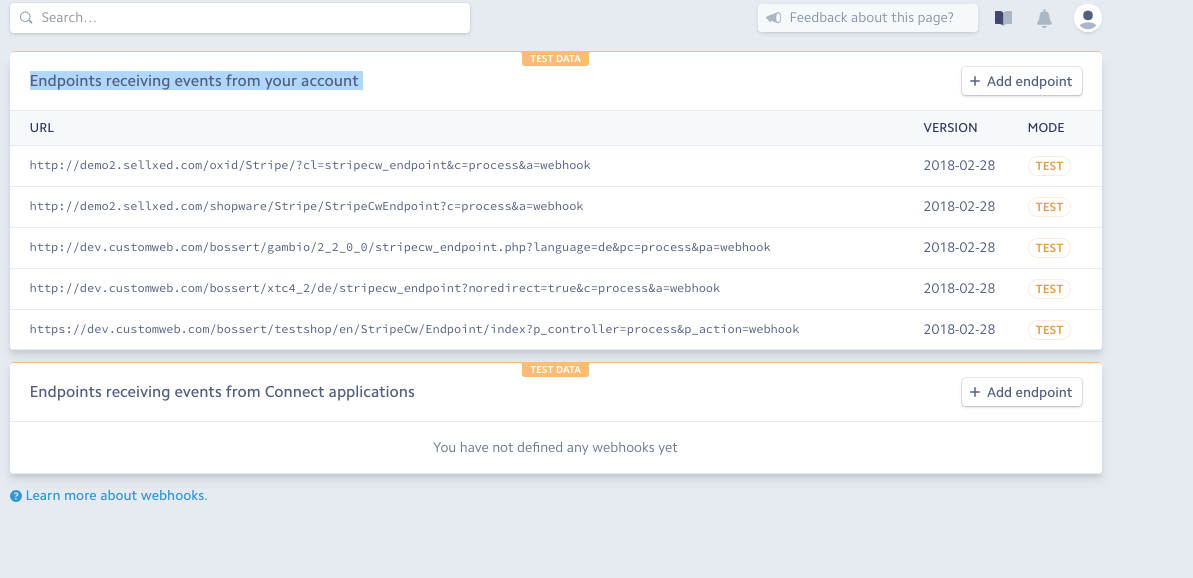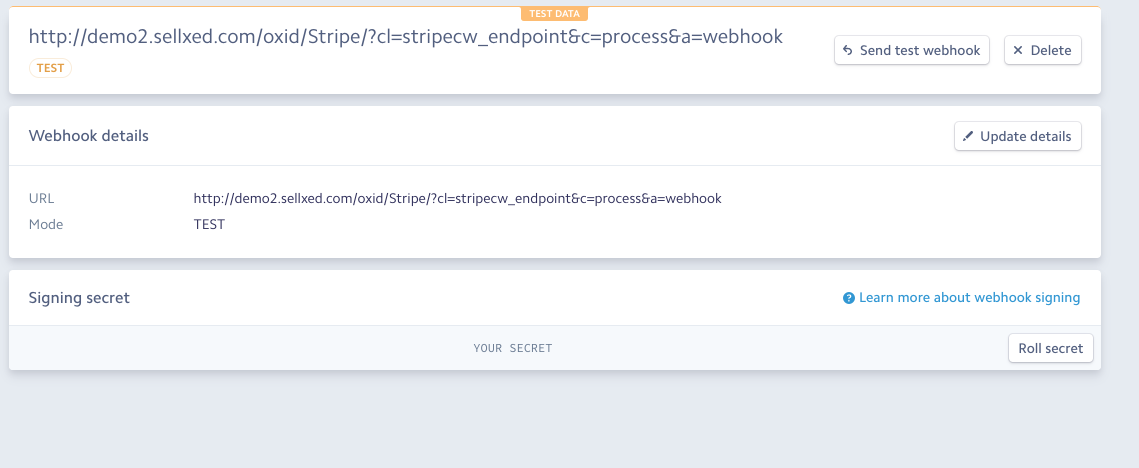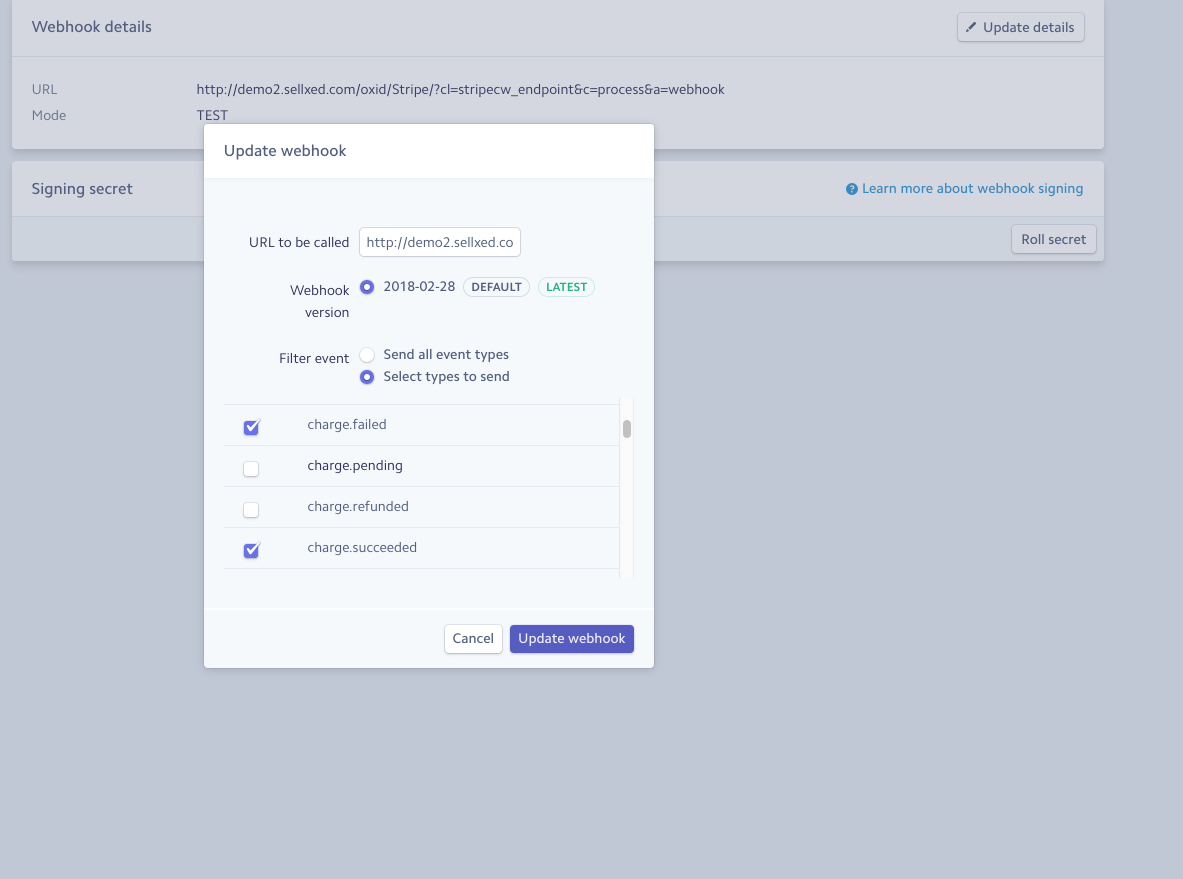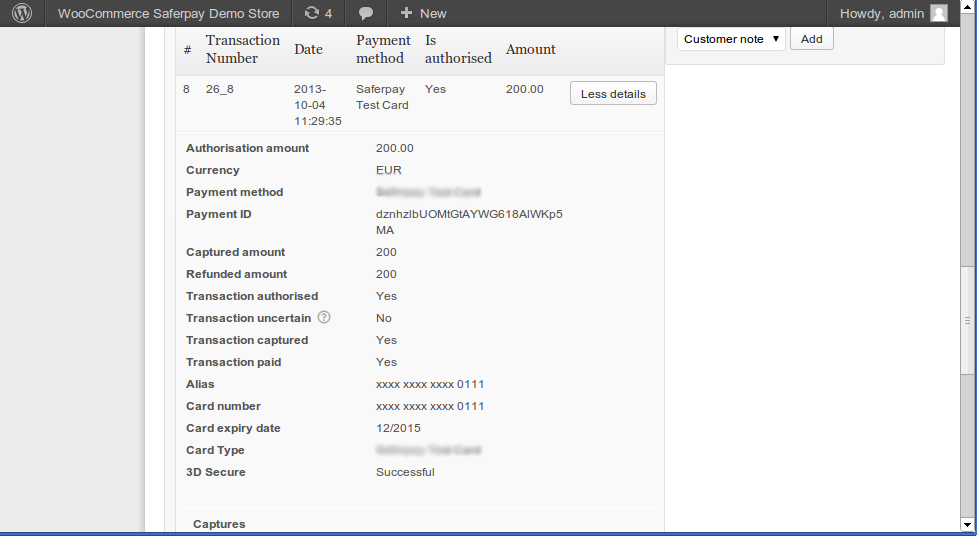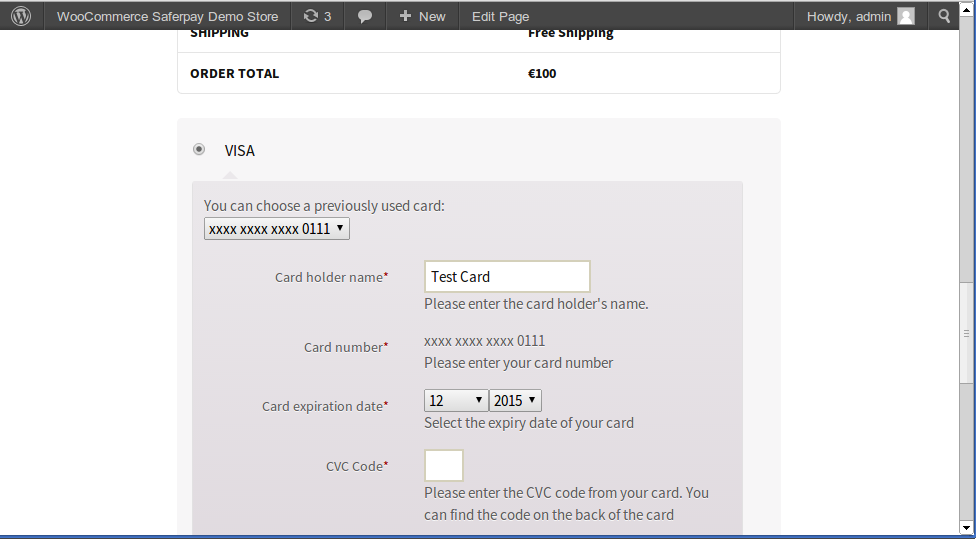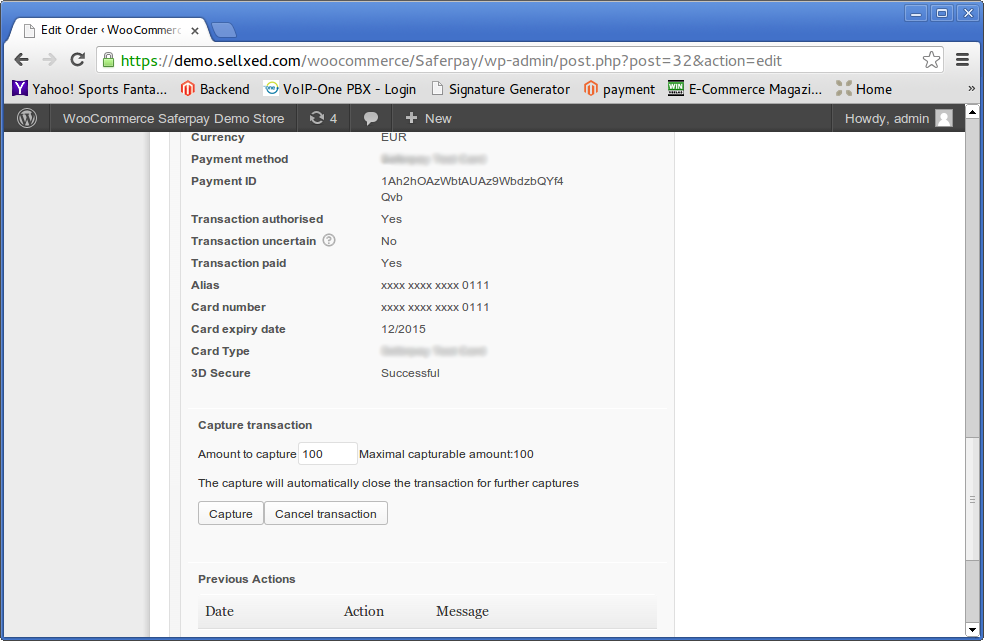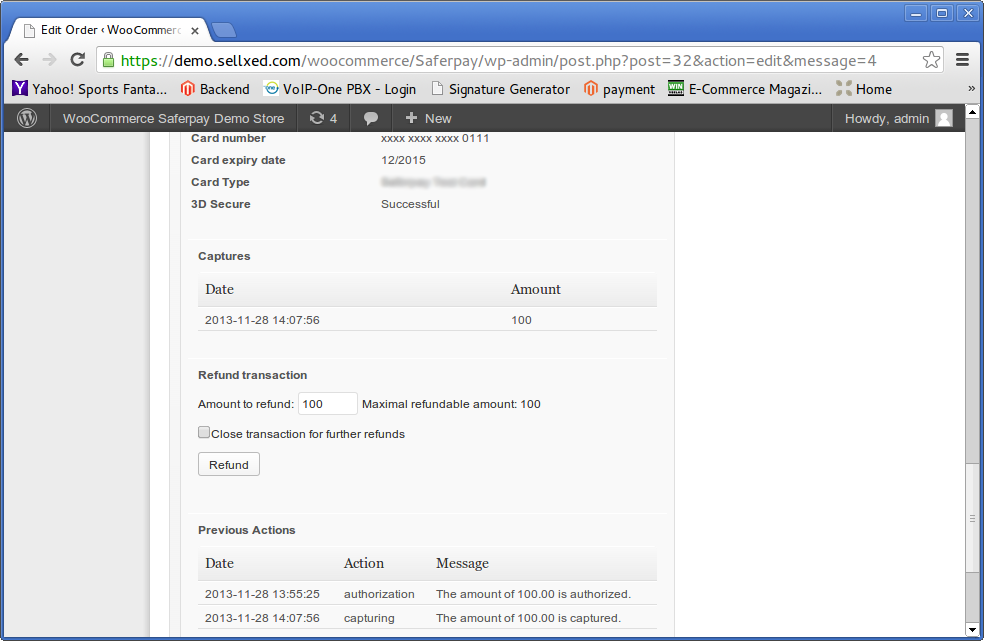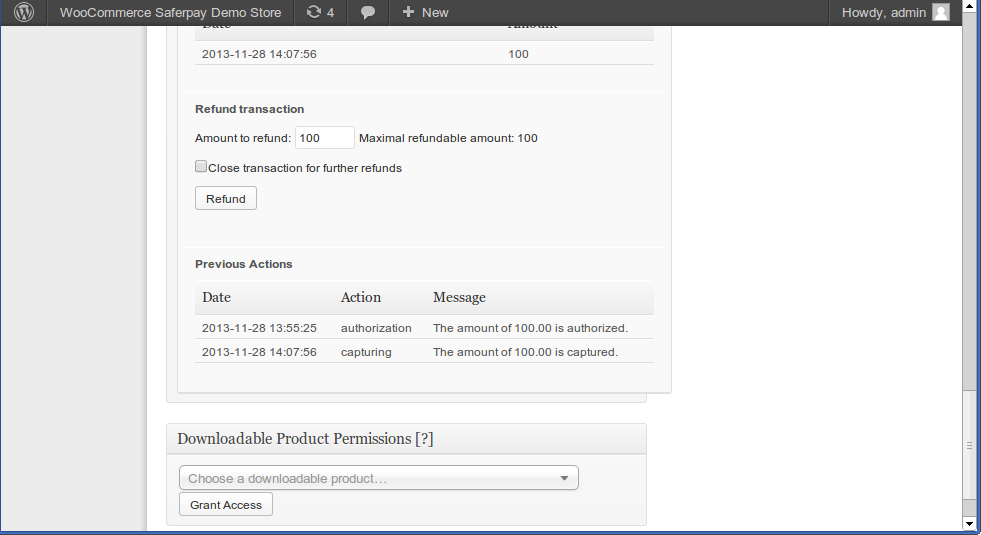1Introduction
This manual describes the installation, configuration and use of the payment module for e-Commerce and Stripe.
Before you can begin with the installation, make sure that you have all the necessary data at hand. You will need:
- Stripe Public Key
- Stripe Secret Key
- e-Commerce payment module from sellxed.com/shop
- Login data for you server and shop
Note that you must use at least PHP version 5.6 for our plugins. PHP 8 or higher is currently not supported.
1.1Installation Process
This document contains all the information necessary to install the module. When activating the module each step must be followed carefully. This ensures the safe use of the module in compliance with all security regulations.
- Configuration of the Main Module
- Configuration of the accepted payment methods as well as the authorization methods
- Conducting a test order
- Activating your Stripe account
Our payment plugins should have per default the correct settings for most of our customers' preferences. That means once you have entered the required credentials in the plugin configuration to connect your account to your website, the plugin should be fully operational. Should you be willing to receive detailed information on a setting you do not know, you may contact our support team who will be able to assist you further.
Our support team is at your disposal during regular business hours at: http://www.sellxed.com/support. Furthermore, you have the option of ordering our installation service. We will make sure the plugin is installed correctly in your shop: http://www.sellxed.com/shop/de/integration-und-installation.html
In order to test the module, any kind of directory protection or IP blocking on your server must be deactivated. This is crucial as otherwise the payment feedback of Stripe might not get through to the shop.
2Stripe Backend Configuration
You can find an overview of the transactions and settings in the backend of Stripe:
- Test Environment: https://dashboard.stripe.com/login
- Live Environment:
2.1Configuration of the Main Module
This is a brief installation instruction of the main and most important installation steps. It is important that you strictly follow the checklist. Only by doing so, the secure usage in correspondence with all security regulations can be guaranteed.
- After having opened your account at Stripe, enter the access data that you received from Stripe into the main module in the space provided.
- Copy the Secret Key that you find in the Stripe Dashboard under Developers > API Keys.
- Copy the Publishable Key that you find in the Stripe Dashboard under Developers > API Keys.
- Create a new endpoint in the Stripe Dashboard under Developers > Webhooks, and enter the link provided in the setup form of the plugin.
- Open the previously created endpoint, and copy the Signing Key. The Signing Key needs to be entered in the main settings of the plugin in the field 'Webhook Secret'.
- Select 'Update Details' and activate the endpoint for the following events: charge.failed, charge.succeeded, source.canceled, source.chargeable, source.failed
- Optional: If you use SEPA, do not forget to configure your merchant name.
2.2Configuration of the Payment Methods
For further information about the configuration of the payment methods and the meaning of each setting, click here. After having activated and configured the payment methods you can run a test by means of the published test data in the manual. If all the tests were successful, switch the operating mode in the main module to Live.
2.3Apple Pay, Google Pay, Microsoft Pay.
These payment methods are only supported on mobile devices and with the required versions (OS and Browser)When a customer is paying via Apple Pay, Googlr Pay, Microsoft Pay a button will be displayed on the screen. ONce this button is pushed the plugin will automatically detect the customers device and open the corresponding app. To use apple pay you need to be registered, all information on this can be found here: https://stripe.com/docs/stripe-js/elements/payment-request-button#verifying-your-domain-with-apple-pay
2.4Additional Styling via Stripe.css
It is possible to style the fields of your form with CSS. For this, you may simply edit the provided stripe.css file inside the module. The input style is defined in .StripeElement, the container is defined in .StripeWrapper. For more information you may visit this link.
3Module Installation and Update in the e-Commerce Shop
3.1Installation
At this time you should already be in possession of the module. Should this not be the case, you can download the necessary files in your customer account in the sellxed shop (Menu "My Downloads Downloads"). In order to install the module in your shop, please carry out the following steps:
- Download the plugin. The download can be found in your sellxed.com account under "My Downloads".
- Unzip the archive you have just downloaded.
- In the unzipped folder navigate to the folder "files"
- For some shops there are different versions of the plugin provided. If this is the case open the folder which corresponds to your shop version.
- Using your preferred FTP client upload entire content of this folder into the root directory of your shop. For some shops there is a specific folder containing the plugins. If that is the case upload the plugin into this folder. Make sure that the folders aren't replaced but merely merged.
- If you haven't yet done so, log back into your shop.
3.2Updates and Upgrades
You have direct and unlimited access to updates and upgrades during the duration of your support contract. In order to receive constant information about available updates we ask you to subscribe to our RSS feed that we publish for your module.
More information regarding the subscription of this RSS feed can be found under: http://www.sellxed.com/en/updates_upgrades.
We only recommend an update if something doesn't work in your shop, if you want to use new feature or if there is a necessary security update.
3.2.1Update Checklist
We ask you to strictly comply with the checklist below when doing an update:
- Always do a backup for your database and your files in your shop
- Use always a test system to test the update process.
- Wait until all the files are copied to the shop, clear the cache if there is one in your shop and then visit the configuration page of the main module so that the update process will be initialized.
Please test the update procedure first in your test shop. Our support team is able and willing to help you if you experience problems with the update process. However, if you decide to perform the update directly in your live shop there is the possibility of a downtime of the shop of more than two days depending on the availability of our support if you do not want to book our complementary support.
Depending on the version it could be that the database has to be migrated. We recommend you therefore, to perform the updates in times when the shop is not visited too frequently by your customers.
3.2.2Update Instructions
Please always read the update instruction. Those instructions can be found in the changelog. If there are no special remarks, you can proceed by just overwriting the files in your system.
4Module Configuration in the e-Commerce Shop
The configuration consists of two steps. The first step is the configuration of the main module with all the basic settings (cf. Configuration of the Main Module). During the second step you can then carry out individual configurations for each payment method . This allows for full flexibility and perfect adaptation to your processes.
Please create a backup of the main directory of your shop. In case of problems you will then always be able to return your shop to its original state.
We furthermore recommend testing the integration on a test system. Complications may arise with third party modules installed by you. In case of questions, our support is gladly at your disposal.
4.1Basic Module Configuration
Activate the plugin by selecting the module E-commerce Stripe in the Plugin menu.
The settings for the basic module can be found at Stripe > Stripe . Fill out the fields, you should have already entered the necessary data in the Stripe backend or you received it as part of your correspondence with Stripe. Each option is explained in more detail in a short info text in the shop.
4.2Setting the Transaction Feedback URL
In order for payments to be processed in your shop you need to enter at least one Feedback URL in the Stripe configuration. The URL can be found in your e-Commerce shop under: Stripe > Setup.
4.3Payment Method Configuration
After the basic module has been configured successfully, you can proceed to the payment settings. The payment methods you want to accept in your shop can be adjusted at Settings > Store > Payments . Every payment method is listed individually. Activate the payment methods you would like to provide in your shop by ticking the corresponding boxes on the right side. Individual changes can be made for each payment method to adjust it to your processes.
4.4Direct Capturing of Transactions
The option "Capture" allows you to specify if you wish to debit payments directly or if you first wish to authorise them and then debit the payment at a later point.
Depending on your acquiring contract, a reservation is only guaranteed for a specific period of time. Should you fail to debit the payment within that period, the authorisation may therefore no longer be guaranteed. Further information on this process can be found below.
It may be that settings saved in the payment modules overwrite settings saved in Stripe.
4.5Uncertain Status
You can specifically label orders for which the money is not guaranteed to be received. This allows you to manually control the order before shipment.
4.5.1Setting the order state
For each payment method you may select in which state the order should be set to depending on the booking state. This is the initial state of the order.
4.6Optional: Validation
Note: It can be that this option is not visible in your module. In this case just ignore this section.
With the option 'Validation' you can define the moment when the payment method should be made visible to the customer during the checkout process. This setting is relevant for modules where the usage depends on the customer's compliance with specific preconditions. For example, if a solvency check has to be carried out or if the payment method is only available in certain countries. In order for the credit check or address validation to also work with European characters, the charset of the "Blowfish mode" must be set to "UTF-8" for certain PSP settings.
You have the choice between these options:
- Validation before the selection of the payment method: A validation verification is carried out before the customer selects the payment method. If the customer does not fulfill the requirements, the payment method is not displayed
- Validation after selection of the payment method: The verification of the compliance occurs after the selection of the payment method and before the confirmation of the order
- During the authorisation: The validation verification is carried out by Stripe during the authorisation process. The payment method is displayed in any case
5Settings / Configuration of Payment Methods
5.1General Information About the Payment Methods
The plugin contains the most common payment methods. In case a desired payment method is not included per default, please contact us directly.
In order to be able to use a payment method, it must be activated in your account with Stripe as well as in your shop. Information about the configuration of the payment methods can be found further above.
Below you can find important information for specific payment methods that deviate from the standard process.
5.2Information on Payment Status
For each payment method you can define an initial payment status (status for authorized payments etc.). You hereby define the payment status for each state depending on the processing type of the order (captured, authorized, etc.). It's the initial status which the order assumes. Depending on the mutation carried out by you, the status can change.
Never set the status to Pending Stripe or any similar pending status which is implemented by the module.
5.2.1Order status "pending" / imminent payment (or similar)
Orders with the status 'pending Stripe' are pending orders. Orders are set to that status if a customer is redirected in order to pay but hasn't returned successfully or the feedback hasn't reached your shop yet (Customer closed window on the payment page and didn't complete payment). Depending on the payment method these orders will automatically be transformed into cancelled orders and the inventory will be cleared (so long as the Cronjob is activated). How long this takes depends on the characteristics of the payment method and cannot be configured.
If you have a lot of pending orders it usually means that the notifications from your webserver to Stripe are being blocked. In this case check the settings of your firewall and ask the Hoster to activate the IPs and User Agents of Stripe.
5.2.2Order status "cancelled"
Orders with the status "cancelled" have either been set to that status automatically due to a timeout, as described above, or have been cancelled directly by the customer.
6The Module in Action
Below you will find an overview of the most important features in the daily usage of the Stripe module.
6.1Useful Information on Transactions
For each order processed with our module you can access an overview of the most important transaction information. Among other things, this allows you to identify each corresponding order to each transaction displayed in the backend.
You can find the orders at Dashboard > Store Sales.
6.2Alias Manager / Token Solution Usage
The Alias Manager allows you to store your customers' credit card data safely with Stripe. You can enable this by activating the option "Alias Manager" in the configuration of the Payment Method. The customer can then select between the saved cards when making purchases in the future and does not have to enter all credit card data again.
In order to use the Alias Manager, the option has to be unlocked by Stripe. Please contact the support service if you wish to activate the option.
6.3Capture / Cancel Orders
6.3.1Capturing and Cancelling Orders
In order to capture orders, open the order first (Dashboard > Store Sales) and then open the transaction information. Enter the amount you want to capture into the input field. By clicking on Capture the card is charged directly.
An order can be cancelled by clicking "Cancel Transaction" and the transaction as well as the reserved amount is released on the customer's card immediately.
The transaction management between Stripe and your shop is not synchronised. When capturing payments in the Stripe, the status is not adjusted in the shop and a second capture is not possible.
Please inquire, whether multiple captures are supported within your Stripe contract. Otherwise, partially captured transactions could be blocked from future captures.
6.4Order Refunds
In order to refund an order, open the transaction information (see above).
You can refund individual items or an arbitrary amount by adjusting the total amount or the number of items.
Our module restricts the refund amount to 100% of the originally authorised amount.
6.5Transaction History
Every action within the transaction management is processed through the module. Information on each transaction can be viewed in the corresponding order.
6.6Cron Job Setup
In order to activate the time-controlled plugin functions (e.g. update service, deleting pending orders etc.) you have to set up cron jobs in e-Commerce. The update function is especially relevant - it allows you to fetch subsequent transaction changes at Stripe via the API. Please keep in mind that additional options might have to be activated.
The module uses the default e-Commerce cron. Information on the setup can be found here.
7Testing
Before switching from test to live mode it is important that you test the module extensively.
Do not forget to switch the operating mode from test to live after having successfully tested the module.
7.1Test Data
In the following section you can find the test data for the various payment methods:Card number 4242424242424242 Expiry Date 12/2020 CVC 123 | VISA |
Card number 4000056655665556 Expiry Date 12/2020 CVC 123 | VISA Debit |
Card number 5555555555554444 Expiry Date 12/2020 CVC 123 | MasterCard |
Card number 5200828282828210 Expiry Date 12/2020 CVC 123 | MasterCard Debit |
Card number 378282246310005 Expiry Date 12/2020 CVC 123 | American Express 1 |
Card number 371449635398431 Expiry Date 12/2020 CVC 123 | American Express 2 |
Card number 6011111111111117 Expiry Date 12/2020 CVC 123 | Discover 1 |
Card number 6011000990139424 Expiry Date 12/2020 CVC 123 | Discover 2 |
Card number 3530111333300000 Expiry Date 12/2020 CVC 123 | JCB 1 |
Card number 3566002020360505 Expiry Date 12/2020 CVC 123 | JCB 2 |
Card number 30569309025904 Expiry Date 12/2020 CVC 123 | Diners 1 |
Card number 38520000023237 Expiry Date 12/2020 CVC 123 | Diners 2 |
Card number 4242424242424242 Expiry Date 12/2020 CVC 123 | VISA |
Card number 4000056655665556 Expiry Date 12/2020 CVC 123 | VISA Debit |
Card number 5555555555554444 Expiry Date 12/2020 CVC 123 | MasterCard |
Card number 5200828282828210 Expiry Date 12/2020 CVC 123 | MasterCard Debit |
Card number 378282246310005 Expiry Date 12/2020 CVC 123 | American Express 1 |
Card number 371449635398431 Expiry Date 12/2020 CVC 123 | American Express 2 |
Card number 6011111111111117 Expiry Date 12/2020 CVC 123 | Discover 1 |
Card number 6011000990139424 Expiry Date 12/2020 CVC 123 | Discover 2 |
Card number 3530111333300000 Expiry Date 12/2020 CVC 123 | JCB 1 |
Card number 3566002020360505 Expiry Date 12/2020 CVC 123 | JCB 2 |
Card number 30569309025904 Expiry Date 12/2020 CVC 123 | Diners 1 |
Card number 38520000023237 Expiry Date 12/2020 CVC 123 | Diners 2 |
8Errors and their Solutions
You can find detailed information under http://www.sellxed.com/en/faq. Should you not be able to solve your problem with the provided information, please contact us directly under: http://www.sellxed.com/en/support
8.1The Referrer URL appears in my Analytics Tool
When a customer and the notification are redirected via Header Redirection, the Stripe Referrer URL might appear in your Analytics Tool thus hiding the original traffic source. However, most Analytic Tools are able to minimize this problem.
In case you are using Google Analytics as reporting tool, this step by step guide may help you to exclude the URLs: under bullet point 4.
9Error Logging
The module will log different unexpected errors or information depending on the configured level. If there is any issue with the module, this log can help identify the cause.
9.1Log Levels
You can configure the log level in the Stripe settings.
- Error: Logs unexpected errors only. (Default)
- Info: Logs extended information.
- Debug: Logs information helpful for debugging.
9.2Log Location
The log file is stored in the logs folder of this plugin wp-content/plugins/plugins/ecommerce_stripecw/logs. Please make sure the path exists and it is writable by the webserver.
10Advanced Information
This section of the manual is for advanced usage of the module. The content is for advanced users with special requirements. Everything in this section is optional and not required for the daily usage of the module.
10.1Transaction Object
This section describes how to extract information from a transaction, if you need it for further processing. E.g. you require more information of the transaction for further processing an order in your ERP system.
The code snippets in this section assume your script resides in the root folder of the shop with the default shop folder structure.
require_once( dirname(__FILE__) . '/wp-load.php' );
require_once ABSPATH.'wp-content/plugins/ecommerce_stripecw/classes/StripeCw/Util.php';
$transactionById = StripeCw_Util::getTransactionById($transactionId); $transactionObject = $transactionById->getTransactionObject();
$transactionByExternal = StripeCw_Util::getTransactionByExternalId($externalId); $transactionObject = $transactionByExternal->getTransactionObject();
$transactionsByOrder = StripeCw_Util::getTransactionsByOrderId($orderId);
foreach($transactionsByOrder as $transaction){
$transactionObject = $transaction->getTransactionObject();
//Do something with each object
}

